Game shows and music gain ground back from news programmes
TV watchers are slowly returning to entertainment, as news spaces begin to decline.
2020-03-30

TV watchers are slowly returning to entertainment, as news spaces begin to decline. Game shows grow by 11 percent in the last week.
Television consumption stabilises after reaching all-time highs.
In our last analysis of the changes in consumption during the first week of the coronavirus, we saw how the consumption of live news and current affairs programmes increased significantly in the first week of confinement; demonstrating how live and institutional broadcasts form one of the cornerstones of linear TV.
And this trend wasn’t only observed on conventional or digital TV, but also visits to news websites and apps increased in Spain and other countries of Europe; in Spain by more than 74%:
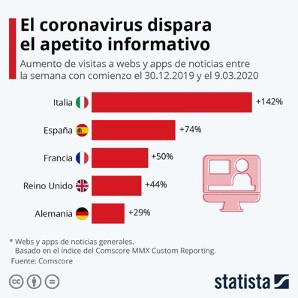
But, what happened to that growing thirst for news - understandable in the first week of confinement - in the following weeks? Did it remain at the same level or did audiences start to feel saturated by coronavirus news or, even, institutional interventions?
As always, we at Mediacrest are watchful of the tastes and audiovisual preferences of the viewers on all windows, so that we can continue to create and adapt our content to audience demands at all times.
In the case of the news and institutional broadcasts on linear TV
As we have indicated previously, “news shows” is the only regularly aired genre that grew on the generalist channels (La1, La2, T5, A3, Cuatro and LaSexta) during the first week of confinement (the week of 9 March it grew by 24% as compared to the previous one). And this has come in detriment to genres like game shows, entertainment and fiction. However, in the second and third weeks (beginning 16 and 23 March) viewing figures already began to come down, in this case, by -7% and -3%, respectively. It seems like audiences are starting to suffer from news saturation.
The result of the genre classified by Kantar as ‘Others’, saw a spectacular rise in the second week, thanks to the address delivered by H.M. the King of Spain last Wednesday 18 March.
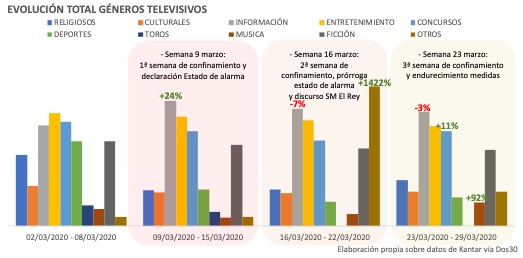
As regards the specialities within the news genre:
The first week of confinement saw growth, above all, in ‘daily’ news shows (+20%, that includes the news and public news broadcasts aired on a daily basis), ‘opinion’ programmes (+36%, among which are programmes like ‘Los desayunos de TVE’, ‘Al rojo vivo’, ‘La Sexta noche’, etc.) and ‘institutional’ news (+85%, this kind of news includes presidential appearances).
But, in the second week there seems to be a certain news saturation and the ‘daily’, ‘opinion’ and especially ‘institutional’ news broadcasts began to decline. But, while in the third week, ‘daily’ and ‘opinion’ continued this downward trend, ‘institutional’ broadcasts surged thanks to the president’s address on 28 March. So, in general, at different times since the confinement began, audiences’ interest in linear TV has remained high, although it is now starting to decrease.

But, how has this interest in the news genre manifested in other windows? In the case of Google Trends:
Searches using the term ‘Coronavirus’ in Spain shot up as of 10 March with the government’s announcement of the closure of education centres in several communities and the recommendation that people work remotely. Interest levels remained at their peak until Sunday 15 March, after which a downward trend began to emerge.
As regards searches related to the president Pedro Sánchez, two key upturns were registered associated with three key presidential appearances: 14 March when the state of alarm was declared in Spain, 22 March when this was extended and 28 March with the introduction of stricter confinement measures. The ‘interest’ in these appearances, however, diminished with each address.
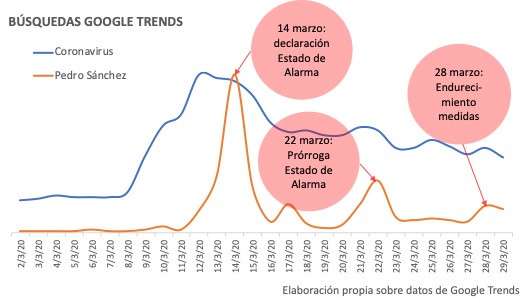
The downward trend in the demand for news resulting from saturation, did not only occur in Spain; in China the interest for news shows on linear TV also began to trace a downward curve, although logically, and as happened in Spain, viewing figures for this genre were still higher than in previous periods.
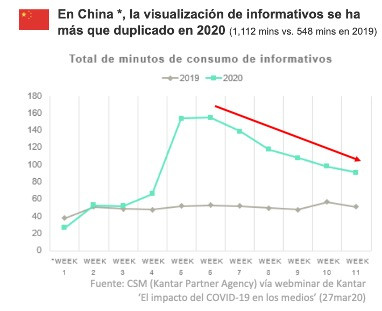
So, in general, the increase in linear TV consumption which was seen in the first week of confinement and which brought with it a record high in tv consumption on Sunday 15 March, remained high, but saw a slight fall over the ensuing weeks.
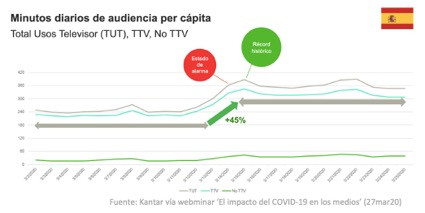
This downward trend in linear TV news shows logically brings with it an upward trend in other genres or forms of consumption:
On linear TV, during the third week of confinement, genres like game shows (+11% with respect to the second week of confinement) or music (+92%) began to grow.
And as for other windows, streaming series and films has become the ideal form of entertainment:
TV consumption through ‘streaming’ has grown 200%.
Searches on platforms like Netflix or HBO have increased 203% and 194%, respectively, during this time with respect to the first week in March.
In the case of Amazon Prime Video and Filmin, their search percentages have grown by more than 100%.
Disney+, which launched on 24 March in Spain, the United Kingdom, Ireland, Austria, Germany, Italy and Switzerland, reached 5 million app downloads in these seven markets on its launch day.
Here at Mediacrest we’re following all the changes. We’ll keep you informed.
We hope you all stay happy and healthy during confinement!!
Sources: Kantar vía Dos30 | Kantar vía webminar 27mar20 | Statista | Google Trend | SEMRush | APP Annie
If you liked it, share it
